Economic Evaluation of the Production of Perennial Crops for Energy Purposes—A Review
Abstract
:1. Introduction
2. Materials and Methods
3. Results and Discussion
3.1. Time and Spatial Analysis
3.2. Journal Analysis
3.3. Cluster Analysis
3.4. Analysis of Crop Species
3.5. Analysis of Methods for Economic Evaluation of Perennial Crop Production
3.6. Analysis of the Value of Economic Indicators
3.7. Analysis of Similarity
4. Conclusions
Author Contributions
Funding
Conflicts of Interest
References
- Goor, F.; Jossart, J.M.; Ledent, J.F. ECOP: An economic model to assess the willow short rotation coppice global profitability in a case of small scale gasification pathway in Belgium. Environ. Model. Softw. 2000, 15, 279–292. [Google Scholar] [CrossRef]
- Cook, J.; Beyea, J. Bioenergy in the United States: Progress and possibilities. Biomass Bioenergy 2000, 18, 441–455. [Google Scholar] [CrossRef]
- Hall, D.O. Biomass energy in industrialised countries—A view of the future. For. Ecol. Manag. 1997, 91, 17–45. [Google Scholar] [CrossRef]
- Fokaides, P.A.; Tofas, L.; Polycarpou, P.; Kylili, A. Sustainability aspects of energy crops in arid isolated island states: The case of Cyprus. Land Use Policy 2015, 49, 264–272. [Google Scholar] [CrossRef]
- Pleguezuelo, C.R.R.; Zuazo, V.H.D.; Bielders, C.; Bocanegra, J.A.J.; Pereatorres, F.; Martínez, J.R.F. Bioenergy farming using woody crops—A review. Agron. Sustain. Dev. 2015, 35, 95–119. [Google Scholar] [CrossRef] [Green Version]
- Glithero, J.N.; Wilson, P.; Ramsden, S.J. Optimal combinable and dedicated energy crop scenarios for marginal land. Appl. Energy 2015, 147, 82–91. [Google Scholar] [CrossRef]
- Acuña, E.; Rubilar, R.; Cancino, J.; Albaugh, T.J.; Maier, C.A. Economic assessment of Eucalyptus globulus short rotation energy crops under contrasting silvicultural intensities on marginal agricultural land. Land Use Policy 2018, 76, 329–337. [Google Scholar] [CrossRef]
- Liu, T.; Huffman, T.; Kulshreshtha, S.; McConkey, B.; Du, Y.; Green, M.; Jiangui, L.; Jiali, S.; Xiaoyuan, G. Bioenergy production on marginal land in Canada: Potential, economic feasibility, and greenhouse gas emissions impacts. Appl. Energy 2017, 205, 477–485. [Google Scholar] [CrossRef]
- Nilsson, D.; Rosenqvist, H.; Bernesson, S. Profitability of the production of energy grasses on marginal agricultural land in Sweden. Biomass Bioenergy 2015, 83, 159–168. [Google Scholar] [CrossRef] [Green Version]
- Schweier, J.; Becker, G. Economics of poplar short rotation coppice plantations on marginal land in Germany. Biomass Bioenergy 2013, 59, 494–502. [Google Scholar] [CrossRef]
- Soldatos, P. Economic Aspects of Bioenergy Production from Perennial Grasses in Marginal Lands of South Europe. Bioenergy Res. 2015, 8, 1562–1573. [Google Scholar] [CrossRef]
- Wagner, M.; Mangold, A.; Lask, J.; Petig, E.; Kiesel, A.; Lewandowski, I. Economic and environmental performance of miscanthus cultivated on marginal land for biogas production. GCB Bioenergy 2019, 11, 34–49. [Google Scholar] [CrossRef] [Green Version]
- Wünsch, K.; Gruber, S.; Claupein, W. Profitability analysis of cropping systems for biogas production on marginal sites in southwestern Germany. Renew. Energy 2012, 45, 213–220. [Google Scholar] [CrossRef]
- Philp, J. The Bioeconomy, the Challenge of the Century for Policy Makers. In New Biotechnology; Elsevier: Amsterdam, The Netherlands, 2018; Volume 40, pp. 11–19. [Google Scholar]
- McKenney, D.W.; Yemshanou, D.; Fraleigh, S.; Allen, D.; Preto, F. An economic assessment of the use of short-rotation coppice woody biomass to heat greenhouses in southern Canada. Biomass Bioenergy 2011, 35, 374–384. [Google Scholar] [CrossRef]
- Lantz, V.; Chang, W.Y.; Pharo, C. Benefit-cost analysis of hybrid willow crop production on agricultural land in eastern Canada: Assessing opportunities for on-farm and off-farm bioenergy use. Biomass Bioenergy 2014, 63, 257–267. [Google Scholar] [CrossRef]
- Pereira, S.; Costa, M.; Carvalho, M.D.; Rodrigues, A. Potential of poplar short rotation coppice cultivation for bioenergy in Southern Portugal. Energy Convers. Manag. 2016, 125, 242–253. [Google Scholar] [CrossRef]
- García-Velásquez, A.C.; Daza, L.; Cardona, C.A. Economic and Energy Valorization of Cassava Stalks as Feedstock for Ethanol and Electricity Production. BioEnergy Res. 2020, 13, 810–823. [Google Scholar] [CrossRef]
- Khanna, M.; Dhungana, B.; Clifton-Brown, J. Costs of producing miscanthus and switchgrass for bioenergy in Illinois. Biomass Bioenergy 2008, 32, 482–493. [Google Scholar] [CrossRef]
- Yuldashev, F.; Illukpitiya, P.; Tegegne, F.; Ekanem, E. Techno-economic analysis of plantation biomass production and small-scale wood pellet processing for bioenergy market. Int. Wood Prod. J. 2020, 11, 173–188. [Google Scholar] [CrossRef]
- Olba-Zięty, E.; Stolarski, M.J.; Krzyżaniak, M.; Gołaszewski, J. Environmental external cost of poplar wood chips sustainable production. J. Clean. Prod. 2020, 252, 119854. [Google Scholar] [CrossRef]
- Auburger, S.; Jacobs, A.; Märländer, B.; Bahrs, E. Economic optimization of feedstock mix for energy production with biogas technology in Germany with a special focus on sugar beets—Effects on greenhouse gas emissions and energy balances. Renew. Energy 2016, 89, 1–11. [Google Scholar] [CrossRef]
- Corno, L.; Pilu, R.; Tambone, F.; Scaglia, B.; Adani, F. New energy crop giant cane (Arundo donax L.) can substitute traditional energy crops increasing biogas yield and reducing costs. Bioresour. Technol. 2015, 191, 197–204. [Google Scholar] [CrossRef] [PubMed]
- Yin, Y.J.; Ma, Z.C.; Nong, G.Z.; Wang, S.F. Strategies of energy management in a cassava starch plant for increasing energy and economic efficiency. J. Clean. Prod. 2019, 234, 1296–1305. [Google Scholar] [CrossRef]
- Shooshtarian, A.; Anderson, J.A.; Armstrong, G.W.; Luckert, M.K. Growing hybrid poplar in western Canada for use as a biofuel feedstock: A financial analysis of coppice and single-stem management. Biomass Bioenergy 2018, 113, 45–54. [Google Scholar] [CrossRef]
- Millinger, M.; Thran, D. Biomass price developments inhibit biofuel investments and research in Germany: The crucial future role of high yields. J. Clean. Prod. 2018, 172, 1654–1663. [Google Scholar] [CrossRef]
- Forleo, M.B.; Palmieri, N.; Suardi, A.; Coaloa, D.; Pari, L. The eco-efficiency of rapeseed and sunflower cultivation in Italy. Joining environmental and economic assessment. J. Clean. Prod. 2018, 172, 3138–3153. [Google Scholar] [CrossRef]
- Akgul, O.; Shah, N.; Papageorgiou, L.G. Economic optimisation of a UK advanced biofuel supply chain. Biomass Bioenergy 2012, 41, 57–72. [Google Scholar] [CrossRef]
- Nguyen, T.T.L.; Gheewala, S.H.; Bonnet, S. Life cycle cost analysis of fuel ethanol produced from cassava in Thailand. Int. J. Life Cycle Assess. 2008, 13, 564–573. [Google Scholar] [CrossRef]
- Brereton, N.J.B.; Berthod, N.; Lafleur, B.; Pedneault, K.; Pitre, F.E.; Labrecque, M. Extractable phenolic yield variation in five cultivars of mature short rotation coppice willow from four plantations in Quebec. Ind. Crop. Prod. 2017, 97, 525–535. [Google Scholar] [CrossRef]
- Haveren, V.J.; Scott, E.L.; Sanders, J. Bulk chemicals from biomass. Biofuels Bioprod. Biorefining 2008, 2, 41–57. [Google Scholar] [CrossRef]
- Malm, A.; Grzegorczyk, A.; Biernasiuk, A.; Baj, T.; Rój, E.; Tyśkiewicz, K.; Dębczak, A.; Stolarski, M.J.; Krzyżaniak, M.; Olba-Zięty, E. Could Supercritical Extracts from the Aerial Parts of Helianthus salicifolius A. Dietr. and Helianthus tuberosus L. Be Regarded as Potential Raw Materials for Biocidal Purposes? Agriculture 2020, 11, 10. [Google Scholar] [CrossRef]
- Tyśkiewicz, K.; Konkol, M.; Kowalski, R.; Rój, E.; Warmiński, K.; Krzyżaniak, M.; Gil, Ł.; Stolarski, M.J. Characterization of bioactive compounds in the biomass of black locust, poplar and willow. Trees-Struct. Funct. 2019, 33, 1235–1263. [Google Scholar] [CrossRef] [Green Version]
- Mola-Yudego, B.; Aronsson, P. Yield models for commercial willow biomass plantations in Sweden. Biomass Bioenergy 2008, 32, 829–837. [Google Scholar] [CrossRef]
- Maaß, O.; Grundmann, P. Added-value from linking the value chains of wastewater treatment, crop production and bioenergy production: A case study on reusing wastewater and sludge in crop production in Braunschweig (Germany). Resour. Conserv. Recycl. 2016, 107, 195–211. [Google Scholar] [CrossRef]
- Krzyzaniak, M.; Stolarski, M.J.; Waliszewska, B.; Szczukowski, S.; Tworkowski, J.; Załuski, D.; Śnieg, M. Willow biomass as feedstock for an integrated multi-product biorefinery. Ind. Crop. Prod. 2014, 58, 230–237. [Google Scholar] [CrossRef]
- Manzone, M.; Airoldi, G.; Balsari, P. Energetic and economic evaluation of a poplar cultivation for the biomass production in Italy. Biomass Bioenergy 2009, 33, 1258–1264. [Google Scholar] [CrossRef]
- Spinelli, R.; Magagnotti, N.; Lombardini, C.; Leonello, E.C. Cost-effective Integrated Harvesting of Short-Rotation Poplar Plantations. BioEnergy Res. 2021, 14, 460–468. [Google Scholar] [CrossRef]
- Spinelli, R.; Cacot, E.; Mihelic, M.; Nestorovski, L.; Mederski, P.; Tolosana, E. Techniques and productivity of coppice harvesting operations in Europe: A meta-analysis of available data. Ann. For. Sci. 2016, 73, 1125–1139. [Google Scholar] [CrossRef] [Green Version]
- Spinelli, R.; Magagnotti, N.; Picchi, G.; Lombardini, C.; Nati, C. Upsized Harvesting Technology for Coping with the New Trends in Short-Rotation Coppice. Appl. Eng. Agric. 2011, 27, 551–557. [Google Scholar] [CrossRef]
- Spinelli, R.; Schweier, J.; de Francesco, F. Harvesting techniques for non-industrial SRF biomass plantations on farmland. J. Agric. Eng. 2013, 44, 5–9. [Google Scholar] [CrossRef]
- Spinelli, R.; Schweier, J.; de Francesco, F. Harvesting techniques for non-industrial biomass plantations. Biosyst. Eng. 2012, 113, 319–324. [Google Scholar] [CrossRef]
- Eisenbies, M.H.; Volk, T.A.; Souza, D.P.L.; Hallen, K.W. Cut-and-chip harvester material capacity and fuel performance on commercial-scale willow fields for varying ground and crop conditions. GCB Bioenergy 2020, 12, 380–395. [Google Scholar] [CrossRef] [Green Version]
- Vanbeveren, S.P.P.; Magagnotti, N.; Spinelli, R. Increasing the Value Recovery from Short-Rotation Coppice Harvesting. Bioresources 2017, 12, 696–703. [Google Scholar] [CrossRef] [Green Version]
- Vanbeveren, S.P.P.; Spinelli, R.; Eisenbies, M.; Schweier, J.; Mola-Yudego, B.; Magagnotti, N.; Acuna, M.; Dimitriou, I.; Ceulemans, R. Mechanised harvesting of short-rotation coppices. Renew. Sustain. Energy Rev. 2017, 76, 90–104. [Google Scholar] [CrossRef]
- Vanbeveren, S.P.P.; Schweier, J.; Berhongaray, G.; Ceulemans, R. Operational short rotation woody crop plantations: Manual or mechanised harvesting? Biomass Bioenergy 2015, 72, 8–18. [Google Scholar] [CrossRef]
- Vanbeveren, S.P.P.; De Francesco, F.; Ceulemans, R.; Spinelli, R. Productivity of mechanized whip harvesting with the Stemster MkIII in a short-rotation coppice established on farmland. Biomass Bioenergy 2018, 108, 323–329. [Google Scholar] [CrossRef]
- Bergante, S.; Manzone, M.; Facciotto, G. Alternative planting method for short rotation coppice with poplar and willow. Biomass Bioenergy 2016, 87, 39–45. [Google Scholar] [CrossRef] [Green Version]
- O’Loughlin, J.; McDonnell, K.; Finnan, J. Quantifying the economic and greenhouse gas balance advantages of establishing miscanthus from stem cuttings. Biomass Bioenergy 2018, 109, 147–154. [Google Scholar] [CrossRef]
- Amponsah, N.Y.; Troldborg, M.; Kington, B.; Aalders, I.; Hough, R.L. Greenhouse gas emissions from renewable energy sources: A review of lifecycle considerations. Renew. Sustain. Energy Rev. 2014, 39, 461–475. [Google Scholar] [CrossRef]
- McCalmont, J.P.; Hastings, A.; McNamara, N.P.; Richter, G.M.; Robson, P.; Donnison, I.S.; Clifton-Brown, J. Environmental costs and benefits of growing Miscanthus for bioenergy in the UK. Glob. Chang. Biol. Bioenergy 2017, 9, 489–507. [Google Scholar] [CrossRef]
- Perrin, A.; Wohlfahrt, J.; Morandi, F.; Ostergard, H.; Flatberg, T.; De la Rua, C.; Bjorkvoll, T.; Gabrielle, B. Integrated design and sustainable assessment of innovative biomass supply chains: A case-study on miscanthus in France. Appl. Energy 2017, 204, 66–77. [Google Scholar] [CrossRef]
- Krzyżaniak, M.; Stolarski, M.J.; Szczukowski, S.; Tworkowski, J. Life Cycle Assessment of New Willow Cultivars Grown as Feedstock for Integrated Biorefineries. Bioenergy Res. 2016, 9, 224–238. [Google Scholar] [CrossRef] [Green Version]
- Bender, M.; Tiedemann, M.; Teuber, L. Online and stochastic optimization for the harvesting of short rotation coppice. J. Clean. Prod. 2016, 110, 78–84. [Google Scholar] [CrossRef]
- Hauk, S.; Skibbe, K.; Röhle, H.; Schröder, J.; Wittkopf, S.; Knoke, T. Nondestructive Estimation of Biomass Yield for Short-Rotation Woody Crops Is Reliable and Shows High Yields for Commercial Stands in Bavaria. BioEnergy Res. 2015, 8, 1401–1413. [Google Scholar] [CrossRef]
- Salles, T.T.; Nogueira, D.A.; Beijo, L.A.; da Silva, L.F. Bayesian approach and extreme value theory in economic analysis of forestry projects. For. Policy Econ. 2019, 105, 64–71. [Google Scholar] [CrossRef]
- Sleight, N.J.; Volk, T.A. Recently Bred Willow (Salix spp.) Biomass Crops Show Stable Yield Trends Over Three Rotations at Two Sites. BioEnergy Res. 2016, 9, 782–797. [Google Scholar] [CrossRef]
- Sleight, N.J.; Volk, T.A.; Johnson, G.A.; Eisenbies, M.H.; Shi, S.; Fabio, E.S.; Pooler, P.S. Change in Yield Between First and Second Rotations in Willow (Salix spp.) Biomass Crops is Strongly Related to the Level of First Rotation Yield. Bioenergy Res. 2016, 9, 270–287. [Google Scholar]
- Havlíčková, K.; Weger, J.; Knápek, J. Modelling of biomass prices for bio-energy market in the Czech Republic. Simul. Model. Pract. Theory 2011, 19, 1946–1956. [Google Scholar] [CrossRef]
- Frank, J.R.; Brown, T.R.; Volk, T.A.; Heavey, J.P.; Malmsheimer, R.W. A stochastic techno-economic analysis of shrub willow production using EcoWillow 3.0 S. Biofuels Bioprod. Biorefining 2018, 12, 846–856. [Google Scholar] [CrossRef]
- Hunkeler, D.; Lichtenvort, K.; Rebitzer, G. Environmental Life Cycle Costing; CRC Press: New York, NY, USA, 2008; p. 191. [Google Scholar]
- Martinho, V.J.P.D. Interrelationships between renewable energy and agricultural economics: An overview. Energy Strategy Rev. 2018, 22, 396–409. [Google Scholar] [CrossRef]
- van Eck, N.J.; Waltman, L. VOSviewer Manual. 2021. Available online: https://www.vosviewer.com/ (accessed on 17 August 2021).
- Clancy, D.; Breen, J.P.; Thorne, F.; Wallace, M. A stochastic analysis of the decision to produce biomass crops in Ireland. Biomass Bioenergy 2012, 46, 353–365. [Google Scholar] [CrossRef]
- Hauk, S.; Knoke, T.; Wittkopf, S. Economic evaluation of short rotation coppice systems for energy from biomass—A review. Renew. Sustain. Energy Rev. 2014, 29, 435–448. [Google Scholar] [CrossRef]
- Stille, L.; Smeets, E.; Wicke, B.; Singh, R.; Singh, G. The economic performance of four (agro-) forestry systems on alkaline soils in the state of Haryana in India. Energy Sustain. Dev. 2011, 15, 388–397. [Google Scholar] [CrossRef]
- Henseler, M.; Röder, N.; Liebersbach, H.; Kreins, P.; Osterburg, B. The mitigation potential and cost efficiency of abatement-based payments for the production of short-rotation coppices in Germany. Biomass Bioenergy 2015, 81, 592–601. [Google Scholar] [CrossRef]
- Hauk, S.; Wittkopf, S.; Knoke, T. Analysis of commercial short rotation coppices in Bavaria, southern Germany. Biomass Bioenergy 2014, 67, 401–412. [Google Scholar] [CrossRef]
- Testa, F.; Fabio, I.; Frey, M.; O’Connor, R. Life Cycle Costing, a View of Potential Applications: From Cost Management Tool to Eco-Efficiency Measurement. Supply Chain Manag. 2011. [CrossRef] [Green Version]
- Testa, R.; Di Trapani, A.M.; Foderà, M.; Sgroi, F.; Tudisca, S. Economic evaluation of introduction of poplar as biomass crop in Italy. Renew. Sustain. Energy Rev. 2014, 38, 775–780. [Google Scholar] [CrossRef]
- Sgroi, F.; Foderà, M.; Trapani, A.M.D.; Tudisca, S.; Testa, R. Economic evaluation of biogas plant size utilizing giant reed. Renew. Sustain. Energy Rev. 2015, 49, 403–409. [Google Scholar] [CrossRef]
- Stolarski, M.J.; Stolarski, M.J.; Rosenqvist, H.; Krzyżaniak, M.; Szczukowski, S.; Tworkowski, J.; Gołaszewski, J.; Olba-Zięty, E. Economic comparison of growing different willow cultivars. Biomass Bioenergy 2015, 81, 210–215. [Google Scholar] [CrossRef]
- Stolarski, M.J.; Olba-Zięty, E.; Rosenqvist, H.; Krzyżaniak, M. Economic efficiency of willow, poplar and black locust production using different soil amendments. Biomass Bioenergy 2017, 106, 74–82. [Google Scholar] [CrossRef]
- Faber, A.; Pudelko, R.; Borek, R.; Borzecka-Walker, M.; Syp, A.; Krasuska, E.; Mathiou, P. Economic potential of perennial energy crops in Poland. J. Food Agric. Environ. 2012, 10, 1178–1182. [Google Scholar]
- Krasuska, E.; Rosenqvist, H. Economics of energy crops in Poland today and in the future. Biomass Bioenergy 2012, 38, 23–33. [Google Scholar] [CrossRef]
- Hoogwijk, M.; Faaij, A.; de Vries, B.; Turkenburg, W. Exploration of regional and global cost-supply curves of biomass energy from short-rotation crops at abandoned cropland and rest land under four IPCC SRES land-use scenarios. Biomass Bioenergy 2009, 33, 26–43. [Google Scholar] [CrossRef] [Green Version]
- Smeets, E.M.W.; Lewandowski, I.M.; Faaij, A.P.C. The economical and environmental performance of miscanthus and switchgrass production and supply chains in a European setting. Renew. Sustain. Energy Rev. 2009, 13, 1230–1245. [Google Scholar] [CrossRef]
- Tharakan, P.J.; Volk, T.A.; Lindsey, C.A.; Abrahamson, L.P. Evaluating the impact of three incentive programs on the economics of cofiring willow biomass with coal in New York State. Energy Policy 2005, 33, 337–347. [Google Scholar] [CrossRef]
- Buchholz, T.; Volk, T.A. Improving the Profitability of Willow Crops—Identifying Opportunities with a Crop Budget Model. BioEnergy Res. 2011, 4, 85–95. [Google Scholar] [CrossRef]
- Langholtz, M.; Eaton, L.; Davis, M.; Shedden, M.; Brandt, C.; Volk, T.; Richard, T. Economic comparative advantage of willow biomass in the Northeast USA. Biofuels Bioprod. Biorefining 2019, 13, 74–85. [Google Scholar] [CrossRef]
- Stanton, B.J.; Bourque, A.; Coleman, M.; Eisenbies, M.; Emerson, R.M.; Espinoza, J.; Gantz, C.; Himes, A.; Rodstrom, A.; Shuren, R.; et al. The practice and economics of hybrid poplar biomass production for biofuels and bioproducts in the Pacific Northwest. Bioenergy Res. 2021, 14, 543–560. [Google Scholar] [CrossRef]
- Yemshanov, D.; McKenney, D. Fast-growing poplar plantations as a bioenergy supply source for Canada. Biomass Bioenergy 2008, 32, 185–197. [Google Scholar] [CrossRef]
- Mantziaris, S.; Iliopoulos, C.; Theodorakopoulou, I.; Petropoulou, E. Perennial energy crops vs. durum wheat in low input lands: Economic analysis of a Greek case study. Renew. Sustain. Energy Rev. 2017, 80, 789–800. [Google Scholar] [CrossRef]
- Ericsson, K.; Rosenqvist, H.; Ganko, E.; Pisarek, M.; Nilsson, L. An agro-economic analysis of willow cultivation in Poland. Biomass Bioenergy 2006, 30, 16–27. [Google Scholar] [CrossRef]
- Styles, D.; Jones, M.B. Energy crops in Ireland: Quantifying the potential life-cycle greenhouse gas reductions of energy-crop electricity. Biomass Bioenergy 2007, 31, 759–772. [Google Scholar] [CrossRef]
- Witzel, C.-P.; Finger, R. Economic evaluation of Miscanthus production—A review. Renew. Sustain. Energy Rev. 2016, 53, 681–696. [Google Scholar] [CrossRef]
- Xue, S.; Kalinina, O.; Lewandowski, I. Present and future options for Miscanthus propagation and establishment. Renew. Sustain. Energy Rev. 2015, 49, 1233–1246. [Google Scholar] [CrossRef]
- El Kasmioui, O.; Ceulemans, R. Financial analysis of the cultivation of poplar and willow for bioenergy. Biomass Bioenergy 2012, 43, 52–64. [Google Scholar] [CrossRef]
- Volk, T.A.; Abrahamson, L.P.; Nowak, C.A.; Smart, L.B.; Tharakan, P.J.; White, E.H. The development of short-rotation willow in the northeastern United States for bioenergy and bioproducts, agroforestry and phytoremediation. Biomass Bioenergy 2006, 30, 715–727. [Google Scholar] [CrossRef]
- Rosenqvist, H.; Berndes, G.; Börjesson, P. The prospects of cost reductions in willow production in Sweden. Biomass Bioenergy 2013, 48, 139–147. [Google Scholar] [CrossRef]
- Konstantinavičienė, J.; Varnagirytė-Kabašinskienė, I.; Škėma, M.; Aleinikovas, M. Assessment of the socio-economic factors affecting the development of willow energy plantations in Lithuania. Balt. For. 2020, 26, 1–8. [Google Scholar] [CrossRef]
- Stadig, L.M.; Tuyttens, F.A.M.; Rodenburg, T.B.; Verdonckt, P.; Wauters, E.; Borremans, L.; Reubens, B. Opportunities for short rotation coppice production on free-range chicken farms in Flanders: Farmers’ perceptions and cost-benefit analysis. Renew. Agric. Food Syst. 2020, 35, 286–295. [Google Scholar] [CrossRef]
- Schiberna, E.; Borovics, A.; Benke, A. Economic Modelling of Poplar Short Rotation Coppice Plantations in Hungary. Forests 2021, 12, 623. [Google Scholar] [CrossRef]
- Faasch, R.J.; Patenaude, G. The economics of short rotation coppice in Germany. Biomass Bioenergy 2012, 45, 27–40. [Google Scholar] [CrossRef]
- Fazio, S.; Barbanti, L. Energy and economic assessments of bio-energy systems based on annual and perennial crops for temperate and tropical areas. Renew. Energy 2014, 69, 233–241. [Google Scholar] [CrossRef]
- Styles, D.; Thorne, F.; Jones, M.B. Energy crops in Ireland: An economic comparison of willow and Miscanthus production with conventional farming systems. Biomass Bioenergy 2008, 32, 407–421. [Google Scholar] [CrossRef]
- Volk, T.A.; Heavey, J.P.; Eisenbies, M.H. Advances in shrub-willow crops for bioenergy, renewable products, and environmental benefits. Food Energy Secur. 2016, 5, 97–106. [Google Scholar] [CrossRef] [Green Version]
- Stanturf, J.A.; Young, T.M.; Perdue, J.H.; Doughetry, D.; Pigott, M.; Guo, Z.; Huang, X. Potential Profitability Zones for Populus spp. Biomass Plantings in the Eastern United States. For. Sci. 2017, 63, 586–595. [Google Scholar]
- Dimitriou, I.; Rosenqvist, H. Sewage sludge and wastewater fertilisation of Short Rotation Coppice (SRC) for increased bioenergy production-Biological and economic potential. Biomass Bioenergy 2011, 35, 835–842. [Google Scholar] [CrossRef]
- Dumortier, J. Impact of agronomic uncertainty in biomass production and endogenous commodity prices on cellulosic biofuel feedstock composition. GCB Bioenergy 2016, 8, 35–50. [Google Scholar] [CrossRef] [Green Version]
- San Miguel, G.; Corona, B.; Ruiz, D.; Landholm, D.; Laina, R.; Tolosana, E.; Sixto, H.; Cañellas, I. Environmental, energy and economic analysis of a biomass supply chain based on a poplar short rotation coppice in Spain. J. Clean. Prod. 2015, 94, 93–101. [Google Scholar] [CrossRef]
- Vyn, R.J.; Virani, T.; Deen, B. Examining the economic feasibility of miscanthus in Ontario: An application to the greenhouse industry. Energy Policy 2012, 50, 669–676. [Google Scholar] [CrossRef]
- De Laporte, A.V.; Weersink, A.J.; McKenney, D.W. A spatial model of climate change effects on yields and break-even prices of switchgrass and miscanthus in Ontario, Canada. GCB Bioenergy 2014, 6, 390–400. [Google Scholar] [CrossRef]
- Dumortier, J.; Kauffman, N.; Hayes, D.J. Production and spatial distribution of switchgrass and miscanthus in the United States under uncertainty and sunk cost. Energy Econ. 2017, 67, 300–314. [Google Scholar] [CrossRef] [Green Version]
- Sorică, E. Analysis of profitability of implementing the miscanthus energetic crop technology for rhizomes capitalization. INMATEH-Agric. Eng. 2015, 46, 155–164. [Google Scholar]
- Allen, D.; McKenney, D.W.; Yemshanov, D.; Fraleigh, S. The economic attractiveness of short rotation coppice biomass plantations for bioenergy in Northern Ontario. For. Chron. 2013, 89, 66–78. [Google Scholar] [CrossRef]
- Krzyżaniak, M.; Stolarski, M.J.; Warmiński, K. Life cycle assessment of poplar production: Environmental impact of different soil enrichment methods. J. Clean. Prod. 2019, 206, 785–796. [Google Scholar] [CrossRef]
- Krzyżaniak, M.; Stolarski, M.J.; Warmiński, K. Life Cycle Assessment of Giant Miscanthus: Production on Marginal Soil with Various Fertilisation Treatments. Energies 2020, 13, 1931. [Google Scholar] [CrossRef]
- Pizzol, M.; Weidema, B.; Brandão, M.; Osset, P. Monetary valuation in Life Cycle Assessment: A review. J. Clean. Prod. 2015, 86, 170–179. [Google Scholar] [CrossRef]
- Pizzol, M.; Laurent, A.; Sala, S.; Weidema, B.; Verones, F.; Koffler, C. Normalisation and weighting in life cycle assessment: Quo vadis? Int. J. Life Cycle Assess. 2017, 22, 853–866. [Google Scholar] [CrossRef] [Green Version]
- Stolarski, M.J.; Krzyżaniak, M.; Warmiński, K.; Załuski, D.; Olba-Zięty, E. Willow Biomass as Energy Feedstock: The Effect of Habitat, Genotype and Harvest Rotation on Thermophysical Properties and Elemental Composition. Energies 2020, 13, 4130. [Google Scholar] [CrossRef]
- Olba-Zięty, E.; Stolarski, M.J.; Krzyżaniak, M.; Warmiński, K. Willow Cultivation as Feedstock for Bioenergy-External Production Cost. Energies 2020, 13, 4799. [Google Scholar] [CrossRef]
- Neugebauer, S.; Forin, S.; Finkbeiner, M. From life cycle costing to economic life cycle assessment-introducing an economic impact pathway. Sustainability 2016, 8, 428. [Google Scholar] [CrossRef] [Green Version]
- Musshoff, O. Growing short rotation coppice on agricultural land in Germany: A Real Options Approach. Biomass Bioenergy 2012, 41, 73–85. [Google Scholar] [CrossRef]
- Regan, C.M.; Connor, J.D.; Raja Segaran, R.; Meyer, W.S.; Bryan, B.A.; Ostendorf, B. Climate change and the economics of biomass energy feedstocks in semi-arid agricultural landscapes: A spatially explicit real options analysis. J. Environ. Manag. 2017, 192, 171–183. [Google Scholar] [CrossRef] [PubMed]
- Buchholz, T.; Volk, T. Profitability of Willow Biomass Crops Affected by Incentive Programs. BioEnergy Res. 2013, 6, 53–64. [Google Scholar] [CrossRef]
- Ridier, A. Farm Level Supply of Short Rotation Woody Crops: Economic Assessment in the Long-Term for Household Farming Systems. Can. J. Agric. Econ. 2012, 60, 357–375. [Google Scholar] [CrossRef]
- Miao, R.; Khanna, M. Effectiveness of the biomass crop assistance program: Roles of behavioral factors, credit constraint, and program design. Appl. Econ. Perspect. Policy 2017, 39, 584–608. [Google Scholar] [CrossRef]
- Ascenso, L.; d’Amore, F.; Carvalho, A.; Bezzo, F. Assessing multiple biomass-feedstock in the optimization of power and fuel supply chains for sustainable mobility. Chem. Eng. Res. Des. 2018, 131, 127–143. [Google Scholar] [CrossRef]
- Knoke, T.; Hildebrandt, P.; Klein, D.; Mujica, R.; Moog, M.; Mosandl, R. Financial compensation and uncertainty: Using mean-variance rule and stochastic dominance to derive conservation payments for secondary forests. Can. J. For. Res. 2008, 38, 3033–3046. [Google Scholar] [CrossRef]
- Skevas, T.; Swinton, S.M.; Tanner, S.; Sanford, G.; Thelen, K.D. Investment risk in bioenergy crops. Glob. Chang. Biol. Bioenergy 2016, 8, 1162–1177. [Google Scholar] [CrossRef] [Green Version]
- Hauk, S.; Gandorfer, M.; Wittkopf, S.; Muller, U.K.; Knoke, T. Ecological diversification is risk reducing and economically profitable—The case of biomass production with short rotation woody crops in south German land-use portfolios. Biomass Bioenergy 2017, 98, 142–152. [Google Scholar] [CrossRef]
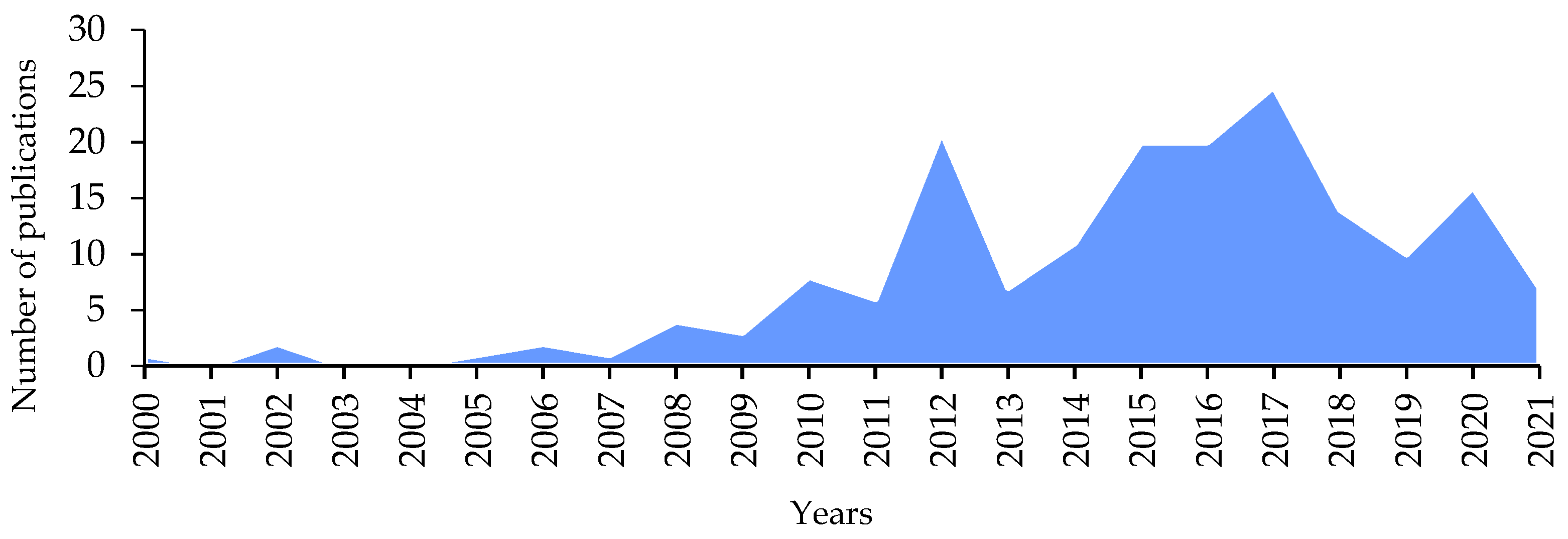
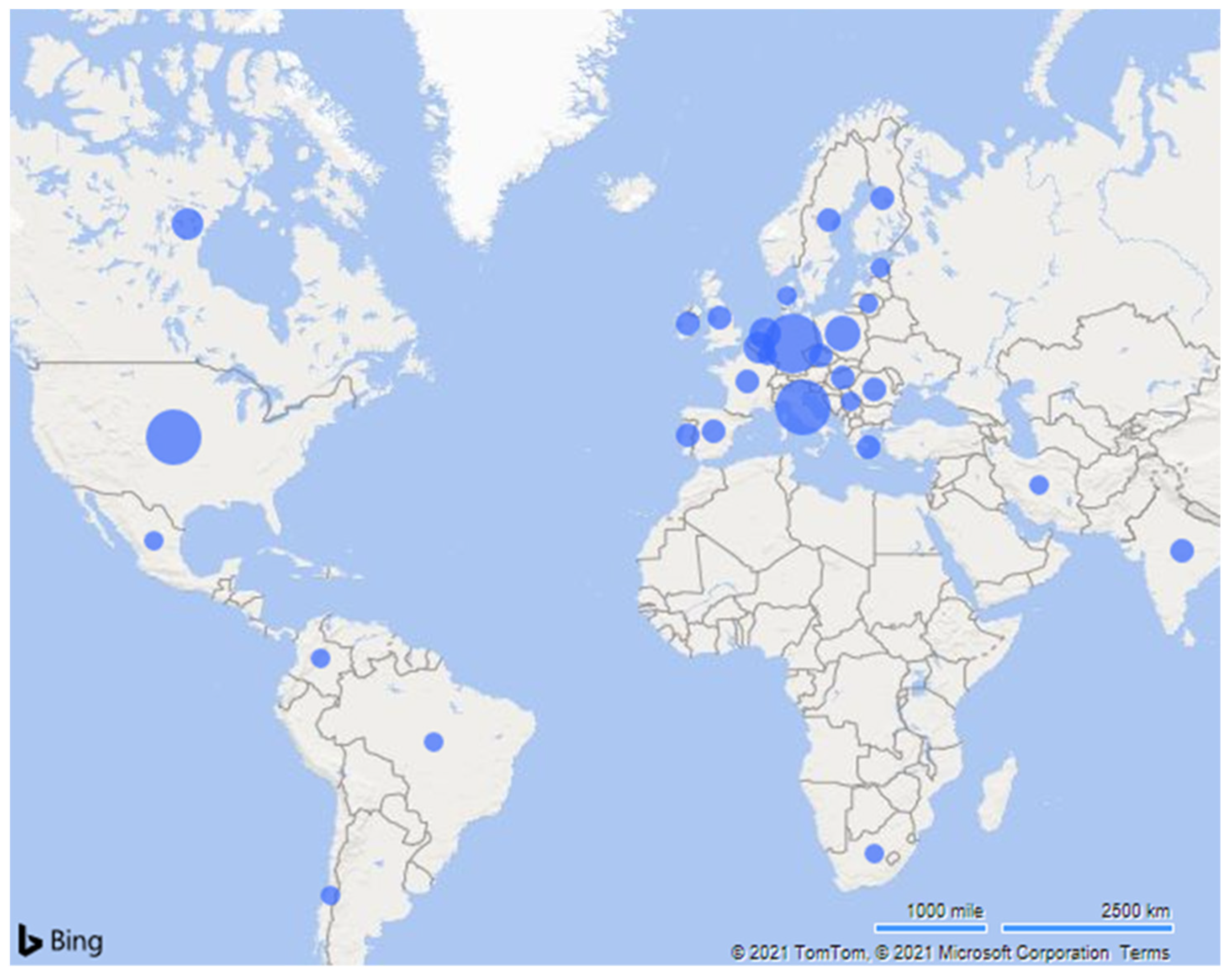
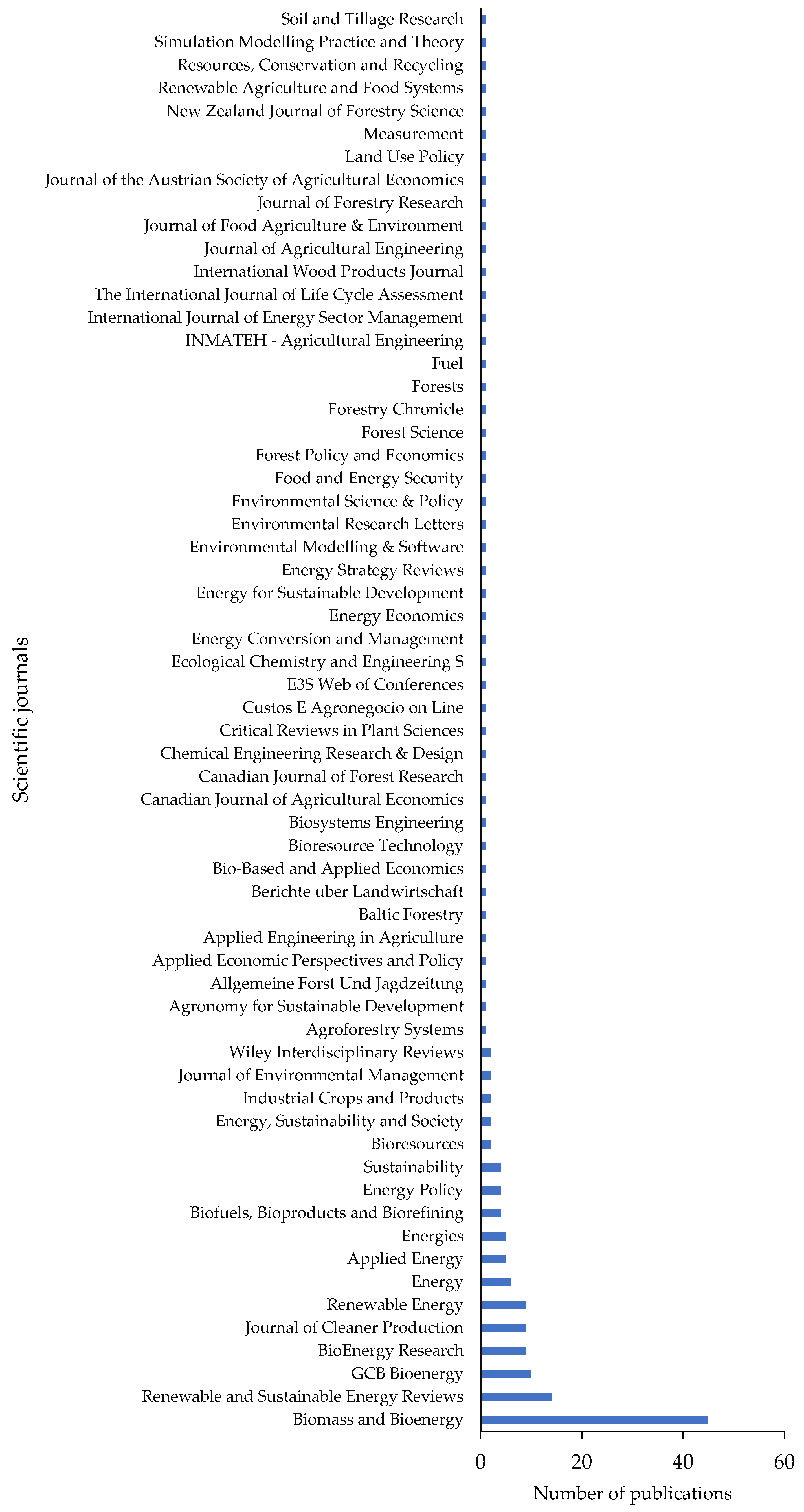
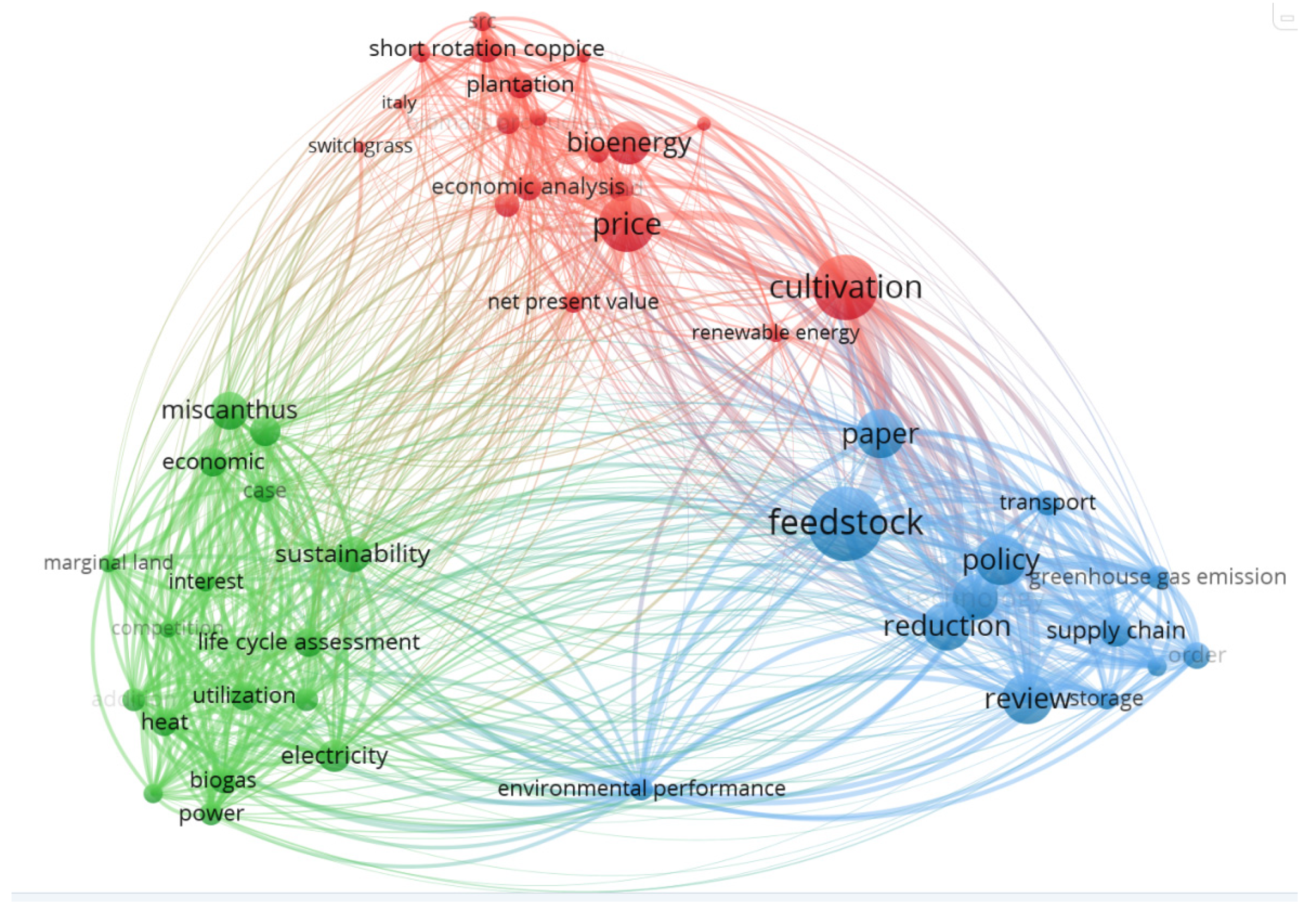
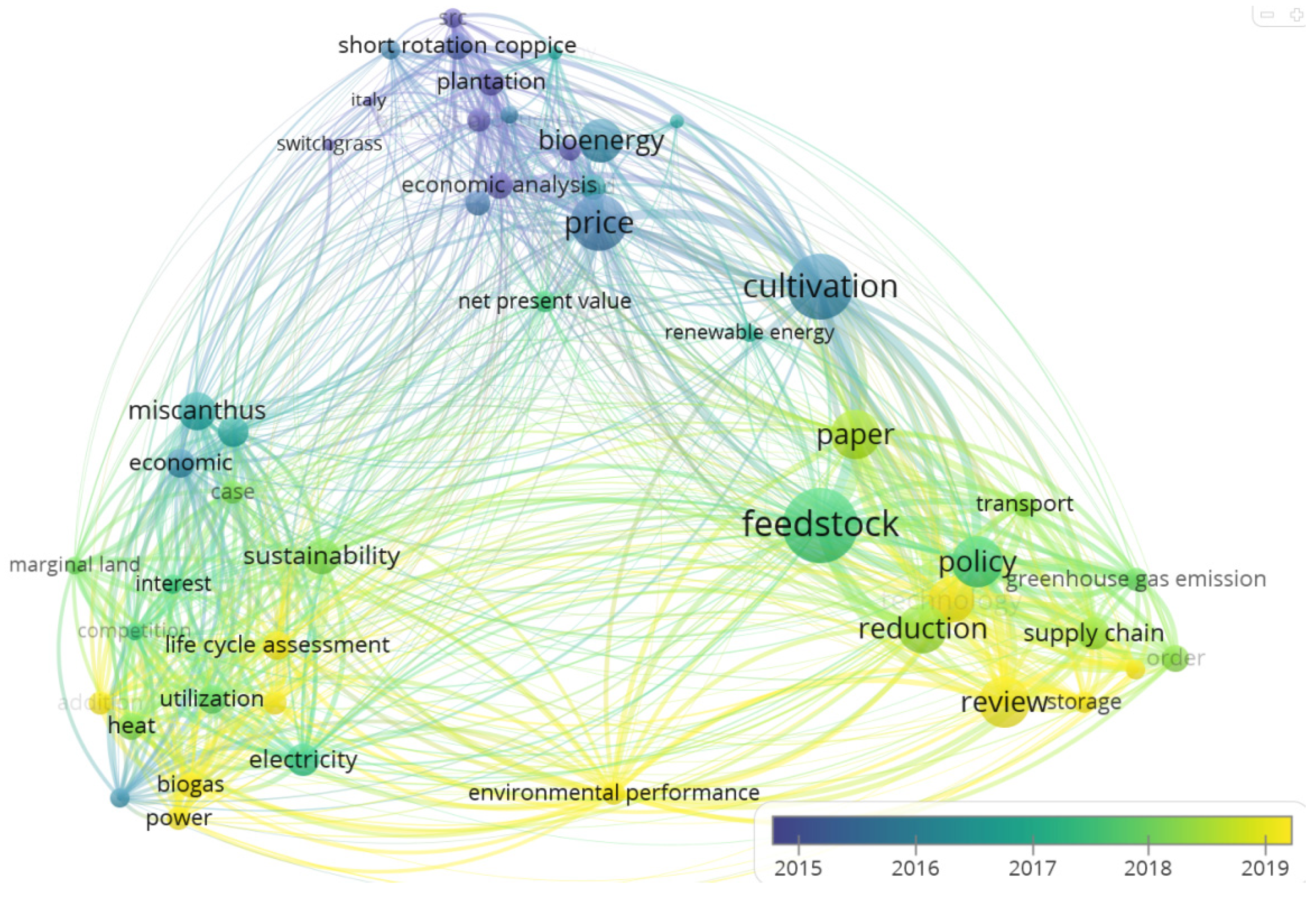
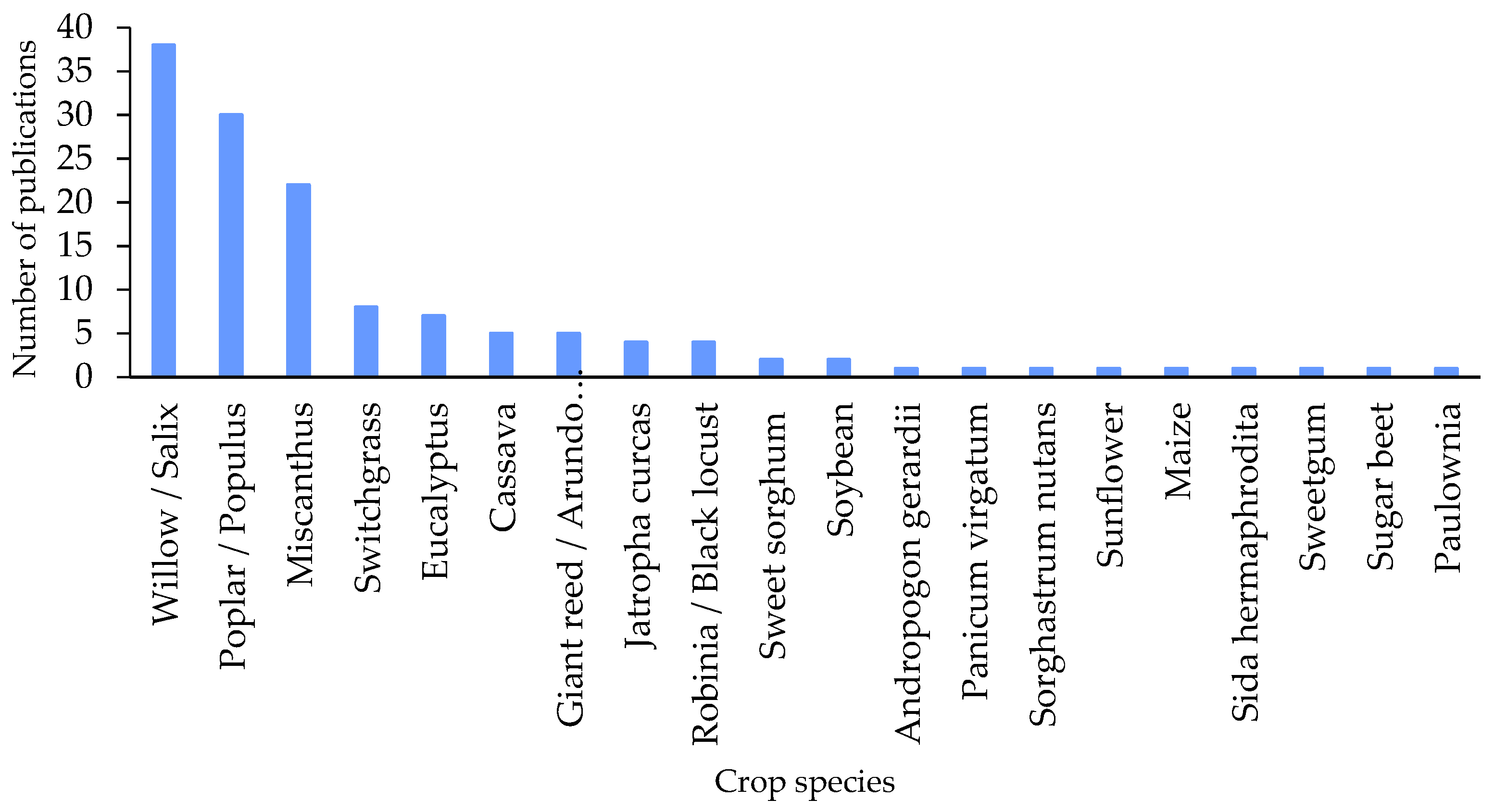
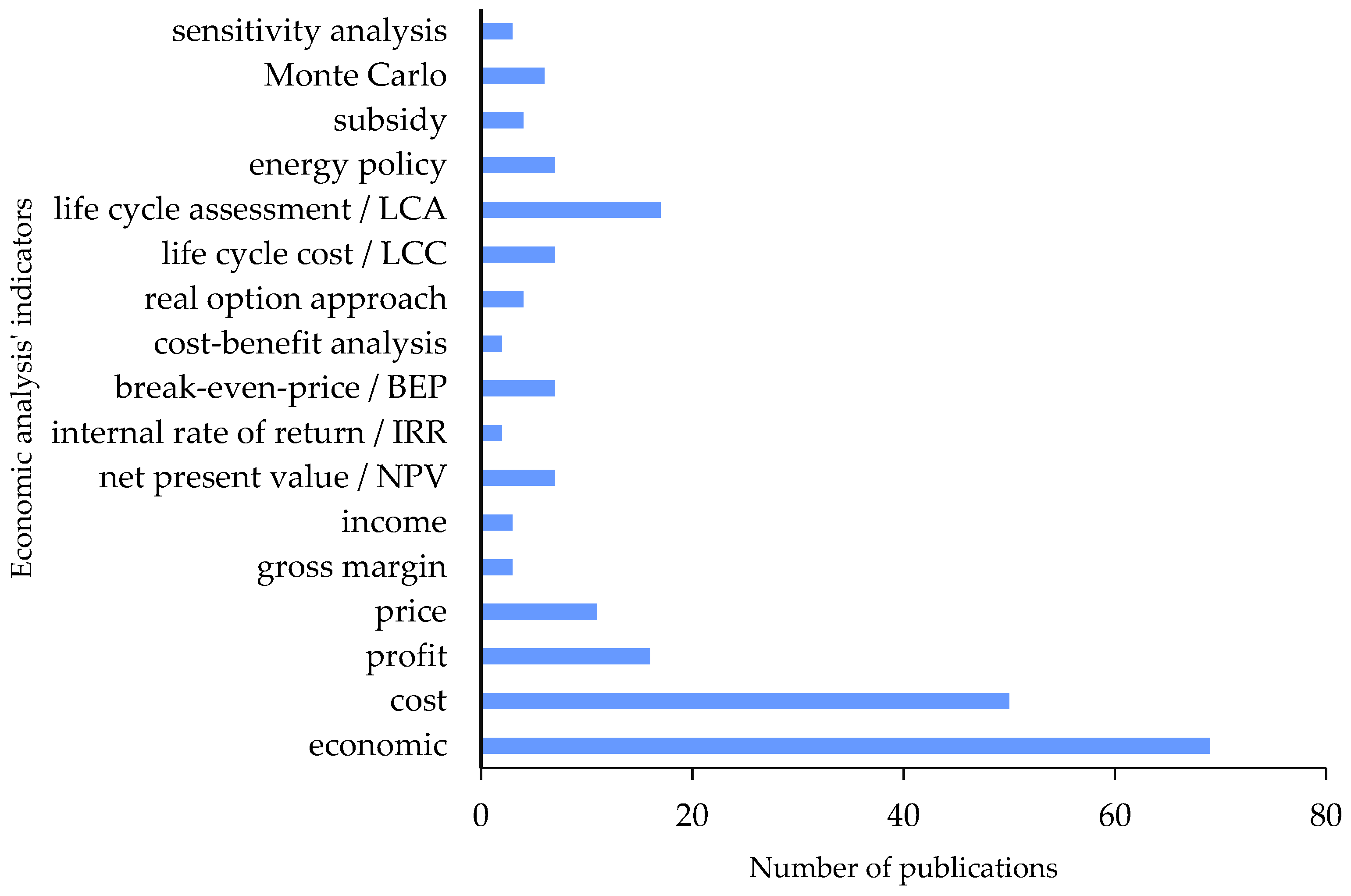
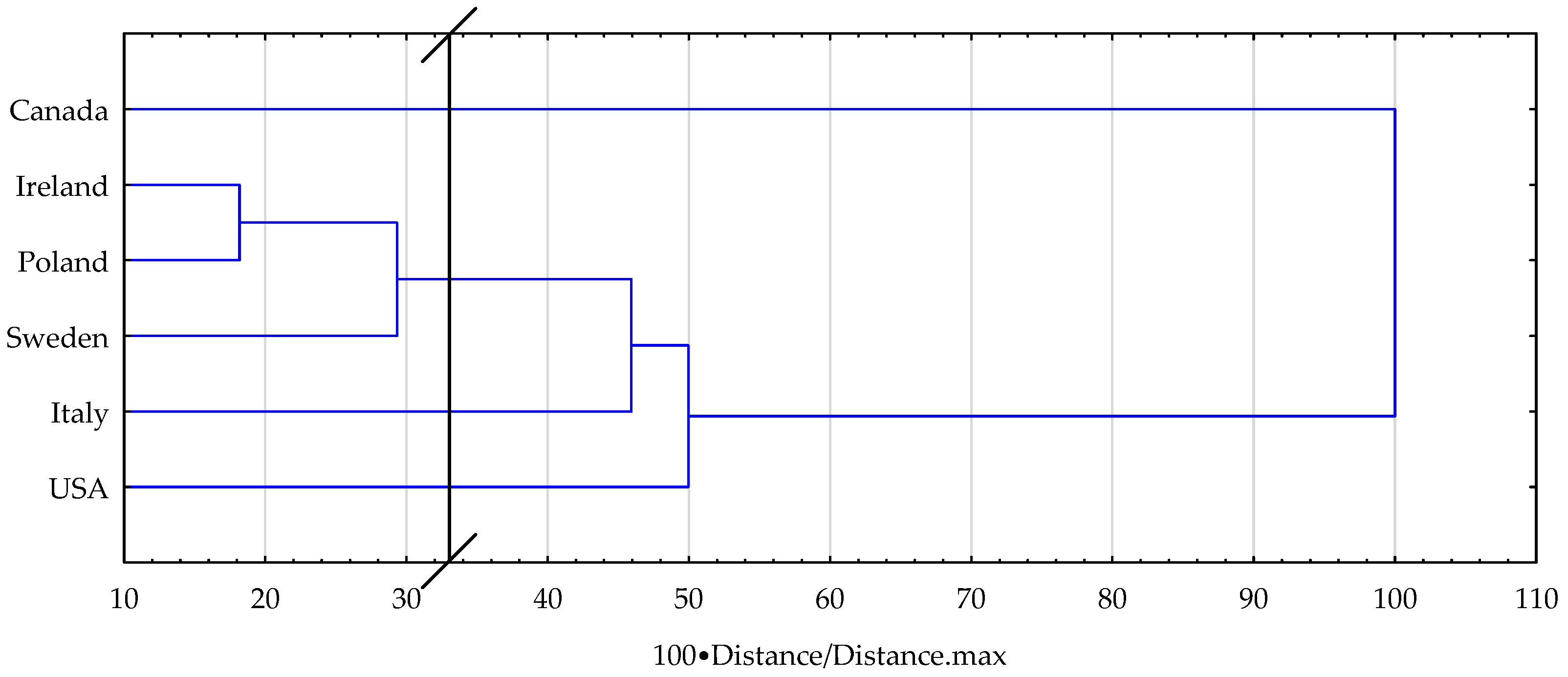
| Variable | Crop | Valid N | Mean | Median | Lower Quartile | Upper Quartile | Stand Dev. | Coef. of Var. |
|---|---|---|---|---|---|---|---|---|
| Lifespan (year) | willow | 31 | 20.08 | 20.00 | 20.00 | 22.00 | 2.63 | 13.08 |
| poplar | 20 | 18.18 | 20.00 | 15.00 | 20.00 | 3.72 | 20.46 | |
| Miscanthus | 12 | 21.11 | 18.00 | 15.50 | 26.00 | 6.89 | 35.09 | |
| Sum a/mean | 63 a | 19.39 | 20.00 | 16.00 | 22.00 | 4.43 | 33.46 | |
| Yield (Mg ha−1 year−1 d.m.) | willow | 44 | 10.71 * | 10.00 | 8.86 | 12.00 | 3.38 | 31.61 |
| poplar | 14 | 9.68 * | 9.28 | 8.51 | 10.00 | 2.87 | 29.62 | |
| Miscanthus | 24 | 29.81 ** | 26.58 | 24.80 | 38.40 | 10.31 | 34.59 | |
| Sum a/mean | 82 a | 16.12 | 11.12 | 9.08 | 23.90 | 10.78 | 66.86 | |
| Cost (EUR Mg−1 d.m.) | willow | 22 | 60.09 | 62.13 | 54.00 | 65.70 | 13.88 | 23.10 |
| poplar | 14 | 69.70 | 73.05 | 60.90 | 77.50 | 17.16 | 24.62 | |
| Miscanthus | 19 | 95.09 | 76.90 | 44.95 | 94.64 | 89.86 | 94.50 | |
| Sum a/mean | 55 a | 74.63 | 64.60 | 54.00 | 77.50 | 55.47 | 74.33 | |
| Cost (EUR ha−1) | willow | 64 | 503.53 * | 442.50 | 236.82 | 668.15 | 328.65 | 65.27 |
| poplar | 26 | 557.23 * | 555.96 | 498.61 | 635.85 | 168.78 | 30.29 | |
| Miscanthus | 32 | 909.07 ** | 1071.51 | 697.31 | 1071.51 | 314.09 | 34.55 | |
| Sum a/mean | 122 a | 621.35 | 567.40 | 375.00 | 878.20 | 342.81 | 55.17 | |
| Cost (EUR GJ−1) | willow | 30 | 3.36 | 3.27 | 2.70 | 3.80 | 1.48 | 44.09 |
| poplar | 12 | 3.70 | 3.60 | 3.10 | 3.95 | 1.32 | 35.55 | |
| Miscanthus | 2 | 3.55 | 3.55 | 2.30 | 4.80 | 1.77 | 49.80 | |
| Sum a/mean | 44 a | 3.46 | 3.29 | 2.75 | 3.90 | 1.42 | 41.05 | |
| BEP (EUR Mg−1 d.m.) | willow | 20 | 118.93 | 135.14 | 118.00 | 146.15 | 47.98 | 40.34 |
| poplar | 6 | 181.51 | 161.00 | 118.00 | 240.67 | 72.58 | 39.99 | |
| Miscanthus | 26 | 97.19 | 87.67 | 73.76 | 93.31 | 56.48 | 58.11 | |
| Sum a/mean | 52 a | 113.36 | 94.43 | 74.29 | 141.63 | 61.23 | 54.01 | |
| Price (EUR Mg−1 d.m.) | willow | 34 | 81.58 | 82.25 | 70.98 | 84.50 | 26.69 | 32.71 |
| poplar | 15 | 82.02 | 81.60 | 81.40 | 90.00 | 11.24 | 13.71 | |
| Miscanthus | 25 | 107.99 | 93.46 | 62.70 | 134.00 | 61.69 | 57.13 | |
| Sum a/mean | 74 a | 90.59 | 82.10 | 71.00 | 100.00 | 41.88 | 46.23 | |
| Price (EUR GJ−1) | willow | 6 | 3.22 | 2.80 | 1.68 | 3.70 | 1.93 | 59.71 |
| poplar | 1 | 4.40 | 4.40 | 4.40 | 4.40 | 0.00 | 0.00 | |
| Miscanthus | 1 | 3.17 | 3.17 | 3.17 | 3.17 | 0.00 | 0.00 | |
| Sum a/mean | 8 a | 3.36 | 3.06 | 2.16 | 4.05 | 1.68 | 49.94 | |
| Revenue (EUR ha−1 year−1) | willow | 69 | 236.30 * | 245.00 | 137.23 | 296.00 | 129.26 | 54.70 |
| poplar | 13 | 180.91 * | 143.00 | 66.90 | 193.90 | 219.95 | 121.58 | |
| Miscanthus | 19 | 404.11 ** | 383.00 | 326.00 | 519.00 | 124.79 | 30.88 | |
| Sum a/mean | 101 a | 260.74 | 252.10 | 143.00 | 335.00 | 158.48 | 60.78 | |
| IRR (%) | willow | 10 | 18.28 | 15.70 | 13.80 | 25.30 | 7.01 | 38.37 |
| poplar | 8 | 11.14 | 9.40 | 7.50 | 16.05 | 4.48 | 40.21 | |
| Miscanthus | 2 | 15.00 | 15.00 | 10.00 | 20.00 | 7.07 | 47.14 | |
| Sum a/mean | 20 a | 15.10 | 14.80 | 10.00 | 18.40 | 6.73 | 44.56 |
Publisher’s Note: MDPI stays neutral with regard to jurisdictional claims in published maps and institutional affiliations. |
© 2021 by the authors. Licensee MDPI, Basel, Switzerland. This article is an open access article distributed under the terms and conditions of the Creative Commons Attribution (CC BY) license (https://creativecommons.org/licenses/by/4.0/).
Share and Cite
Olba-Zięty, E.; Stolarski, M.J.; Krzyżaniak, M. Economic Evaluation of the Production of Perennial Crops for Energy Purposes—A Review. Energies 2021, 14, 7147. https://doi.org/10.3390/en14217147
Olba-Zięty E, Stolarski MJ, Krzyżaniak M. Economic Evaluation of the Production of Perennial Crops for Energy Purposes—A Review. Energies. 2021; 14(21):7147. https://doi.org/10.3390/en14217147
Chicago/Turabian StyleOlba-Zięty, Ewelina, Mariusz Jerzy Stolarski, and Michał Krzyżaniak. 2021. "Economic Evaluation of the Production of Perennial Crops for Energy Purposes—A Review" Energies 14, no. 21: 7147. https://doi.org/10.3390/en14217147
APA StyleOlba-Zięty, E., Stolarski, M. J., & Krzyżaniak, M. (2021). Economic Evaluation of the Production of Perennial Crops for Energy Purposes—A Review. Energies, 14(21), 7147. https://doi.org/10.3390/en14217147








